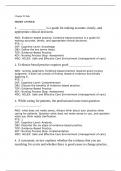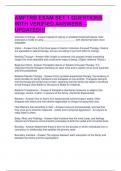Chapter 01.bnk
SHORT ANSWER
1._________________ is a guide for making accurate, timely, and
appropriate clinical decisions.
ANS: Evidence-based practice, Evidence-based practice is a guide for
making accurate, timely, and appropriate clinical decisions.
PTS: 1
DIF: Cognitive Level: Knowledge
OBJ: Define the key terms listed.
TOP: Evidence-Based Practice
KEY: Nursing Process Step: Assessment
MSC: NCLEX: Safe and Effective Care Environment (management of care)
2. Evidence-based practice requires good ______________.
ANS: nursing judgment, Evidence-based practice requires good nursing
judgment, it does not consist of finding research evidence and blindly
applying it.
PTS: 1
DIF: Cognitive Level: Comprehension
OBJ: Discuss the benefits of evidence-based practice.
TOP: Evidence-Based Practice
KEY: Nursing Process Step: Assessment
MSC: NCLEX: Safe and Effective Care Environment (management of care)
3.While caring for patients, the professional nurse must question
________________.
ANS: what does not make sense, Always think about your practice when
caring for patients. Question what does not make sense to you, and question
what you think needs clarification.
PTS: 1
DIF: Cognitive Level: Analysis
OBJ: Describe the six steps of evidence-based practice.
TOP: Evidence-Based Practice
KEY: Nursing Process Step: Implementation
MSC: NCLEX: Safe and Effective Care Environment (management of care)
4.A systematic review explains whether the evidence that you are
searching for exists and whether there is good cause to change practice.
,In _____________, all entries include information on systematic
reviews.
ANS: The Cochrane Database, A systematic review explains whether the
evidence that you are searching for exists and whether there is good cause
to change practice. In The Cochrane Database, all entries include
information on systematic reviews.
PTS: 1
DIF: Cognitive Level: Analysis
OBJ: Describe the six steps of evidence-based practice.
TOP: Evidence-Based Practice
KEY: Nursing Process Step: Implementation
MSC: NCLEX: Safe and Effective Care Environment (management of care)
5. The researcher explains how to apply findings in a practice setting for
the types of subjects studied in the _________________ section of a
research article.
ANS: “Clinical Implications”, Clinical Implications, A research article includes
a section that explains whether the findings from the study have “clinical
implications.” The researcher explains how to apply findings in a practice
setting for the types of subjects studied.
PTS: 1
DIF: Cognitive Level: Application
OBJ: Discuss elements to review when critiquing the scientific literature.
TOP: Randomized Controlled Trials
KEY: Nursing Process Step: Implementation
MSC: NCLEX: Safe and Effective Care Environment (management of care)
6.____________________ is the extent to which a study's findings are
valid, reliable, and relevant to your patient population of interest.
ANS: Scientific rigor, Scientific rigor is the extent to which a study’s findings
are valid, reliable, and relevant to your patient population of interest.
PTS: 1
DIF: Cognitive Level: Application
OBJ: Define the key terms listed.
TOP: Randomized Controlled Trials
KEY: Nursing Process Step: Implementation
MSC: NCLEX: Safe and Effective Care Environment (management of care)
7. Patient fall rates are an example of an ______________.
,ANS: outcome measurement, Data collected within a health care agency
offer important trending information about clinical conditions and problems.
Staff in the agency review the data periodically to identify problem areas and
to seek solutions.
PTS: 1
DIF: Cognitive Level: Application
OBJ: Define the key terms listed.
TOP: Quality Improvement
KEY: Nursing Process Step: Implementation
MSC: NCLEX: Safe and Effective Care Environment (management of care)
MULTIPLE CHOICE
1.Evidence-based practice is a problem-solving approach to making
decisions about patient care that is grounded in:
a. the latest information found in textbooks.
b. systematically conducted research studies.
c. tradition in clinical practice.
d. quality improvement and risk-management data.
ANS: b
The best evidence comes from well-designed, systematically conducted
research studies described in scientific journals. Portions of a textbook
often become outdated by the time it is published. Many health care
settings do not have a process to help staff adopt new evidence in
practice, and nurses in practice settings lack easy access to
risk-management data, relying instead on tradition or convenience.
Some sources of evidence do not originate from research. These include
quality improvement and risk-management data; infection control data;
retrospective or concurrent chart reviews; and clinicians' expertise.
Although non–research-based evidence is often very valuable, it is
important that you learn to rely more on research-based evidence.
PTS: 1
DIF: Cognitive Level: Comprehension
OBJ: Discuss the benefits of evidence-based practice.
TOP: Evidence-Based Practice
KEY: Nursing Process Step: Assessment
MSC: NCLEX: Safe and Effective Care Environment (management of care)
, 2. When evidence-based practice is used, patient care will be:
a. standardized for all.
b. unhampered by patient culture.
c. variable according to the situation.
d. safe from the hazards of critical thinking.
ANS: c
Using your clinical expertise and considering patients' cultures, values,
and preferences ensures that you will apply available evidence in
practice ethically and appropriately. Even when you use the best
evidence available, application and outcomes will differ; as a nurse, you
will develop critical thinking skills to determine whether evidence is
relevant and appropriate.
PTS: 1
DIF: Cognitive Level: Application
OBJ: Discuss the benefits of evidence-based practice.
TOP: Evidence-Based Practice
KEY: Nursing Process Step: Assessment
MSC: NCLEX: Safe and Effective Care Environment (management of care)
3. When a PICOT question is developed, the letter that corresponds with
the usual standard of care is:
a. P.
b. I.c.
c. CHOICE BLANK
d. O.
ANS: c
C = Comparison of interest. What standard of care or current
intervention do you usually use now in practice?
P = Patient population of interest. Identify your patient by age, gender,
ethnicity, disease, or health problem.
I = Intervention of interest. What intervention (e.g., treatment, diagnostic
test, and prognostic factor) do you think is worthwhile to use in practice?
O = Outcome. What result (e.g., change in patient's behavior, physical





